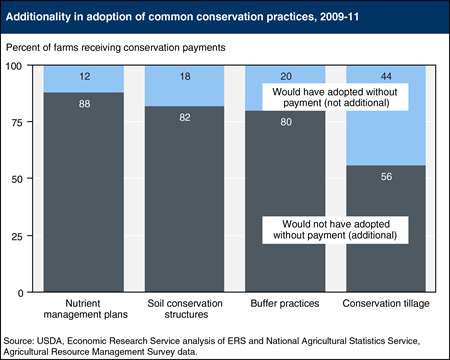Source: USDA-ARS Charts of Note
Under the Agricultural Act of 2014, Congress provided an estimated $28 billion in mandatory 2014-18 funding for USDA conservation program payments that encourage farmers to adopt conservation practices.
If farmers would have adopted the practice even without financial incentive, however, the practices are not “additional,” and the payments provide income for farmers without improving environmental quality. Some farmers have adopted specific conservation practices without receiving payments because doing so reduces production costs or preserves the long-term productivity of their farmland (e.g., strip-till).
Many other farmers have not adopted conservation practices, presumably because the cost of doing so exceeds expected onfarm benefits, the value of which can vary based on many factors, including soil, climate, topography, crop/livestock mix, producer management skills, and risk aversion.
Since the value of onfarm benefits can vary widely across practices and farms, identifying which farmers will adopt a conservation practice only if they receive a payment is not straightforward.
Additionality tends to be high for practices that are expensive to install, have limited onfarm benefits, or onfarm benefits that accrue only in the distant future (e.g., soil conservation structures, buffer practices, and written nutrient management plans). Practices that can be profitable in the short term are more likely to be adopted without payment assistance and tend to be less additional (e.g., conservation tillage).
Research indicates that the likelihood a payment will result in additional environmental benefit increases as the implementation cost of the conservation practice increases (such as soil conservation structures) and its impact on farm profitability declines. This chart is based on data from the ERS report, Additionality in U.S. Agricultural Conservation and Regulatory Offset Programs, ERR-170, July 2014.







Post a comment
Report Abusive Comment